Spaces that stories can inhabit
This craft essay and book review was featured at medium.com in May of 2019. In it I conjecture what it might be like to fashion a novel as a fractal. The novel I was thinking of writing was a sequel to my 2018 thriller Turkey Shoot that would feature its female protagonist. With that in mind I began writing Her Own Devices the following month, completing the first draft a year later. It turned out not to be another thriller, as I’d expected, but a crime story. Is it a fractal? Not in any formal sense, but it does feature certain repeating elements. I’m currently fractalizing its fourth revision.
See the original story here (counts as one of three free articles non-subscribers to Medium may view each month).
“What I hope this book now will leave behind: the idea that new patterns like spirals or explosions or vortex streets might open our eyes to other natural shapes underlying our stories, might let us step away from the arc sometimes, slip under or through that powerful wave, glorious as it can be. I hope that other patterns might help us imagine new ways to make our narratives vital and true, keep making our novels novel.”
Jane Alison, Meander, Spiral, Explode: Design and Pattern in Narrative, Catapult, 2018, pages 248-9.
Think of a snowflake forming around a molecule of water clinging to a tiny particle of something, how it blossoms and diverges as other molecules join in, seeking their hexagonal destiny, becoming a perfect thing of beauty. Then think of it melting, its sharp edges blurring, its interstices blotting out until it plops to earth. That’s a story, right there, in full surround. Matter, space and time at play.
The last two sentences in Jane Alison’s brief book, quoted above, hint at a broader range of spatial patterns that authors she discusses have deployed in fiction, seeing fractals, meanders, networks and other geometric structures as literary armatures that can supplant or coexist with the conventional Aristotelian beginning-middle-end story arc.
Now and then I’ve considered starting a sequel to Turkey Shoot, but felt stymied because no plot seemed to gel. I had what could be its central protagonist and a possible situation for her, but no idea what should come first, next or last, or even the location or time frame the story would take place in. Perhaps, I thought upon reading Alison’s approach to crafting stories, I should think different. Meander, Spiral, Explode might help me tunnel through my writer’s block.
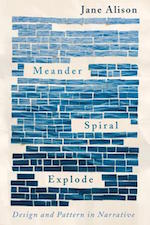
Were I to undertake a sequel, I could integrate as many of her spatial metaphors as might seem to fit, but not just as literary gimmicks. I want to learn if their expressive power across different locals, scenes, characters, and subplots helps me to structure a novel in the fullness of space-time. Embracing spatiality might liberate me from rolling out a plot like a reel of magnetic tape. (Remember them?)
A tape player has two reels, one full and one empty to begin with. In between them sits a component called a “head” that “reads” electrical patterns on the tape as it is drawn at a steady pace by the “take-up” reel, just as we read by flipping pages from the full side of a flattened book to its empty side.
Sounds and images on tape unwind, as do books. Wound up, a tape forms a spiral and a book a stack whose narrative generally obeys Aristotle’s poetics but doesn’t really have to. You can lose yourself in a book or a tape, but should you skip around in it you may get lost. Instead of being static tape heads, readers could be higher-dimension beings that crawl back and forth along the spiral or leap radially to other tracks. Think of the medium as a matrix of content that only seems to move and change because you navigate sequentially through it. But be it a story or a symphony, it should have structure, an overall architecture that once perceived and appreciated gives delight.
Any of the structures that Alison purloins from geometry—she explores waves, wavelets, meanders, spirals, explosions, networks, fractals, and tsunamis—can be metaphorically deployed in a novel or even a short story as literary devices. Take snowflakes, which are both “explosions” and “fractals,” forms that several authors whose prose she deconstructs have deployed to structure narratives. Of all the species in her menagerie of geometries, the one that attracts me most is fractals, perhaps the toughest one to translate into narratives.[1] Fractals are “self-similar,” generated from a seed that replicates into a mosaic or other pattern through time and space and across scales; as you zoom in or out, you see more of the same thing in every nook and cranny.
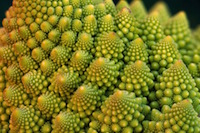
Fractals aren’t just math. They flower spontaneously, organically throughout the natural world. True to themselves, snails spiral, rivers branch, coastlines crinkle. But few pieces of literature seem to have such holistic qualities beyond displaying a consistent, self-similar style. To evoke them in writing seems hard, if not unnatural. Alison’s exemplar of fractalized prose is Cloud Atlas by David Mitchell, a set of stories structured with palindromic symmetry—12345654321, not unlike a snowflake’s armature: “six long stories, one nested in the next” that “run from the 1850s into a shattered far future, and each story features someone who is weak and others who are monstrously powerful.” The first five are revisited in reverse order following the central (futuristic) one, “the only one told whole.” But each of its “cells,” she writes, “has its own texture and colors, and each makes the same sort of moves.”
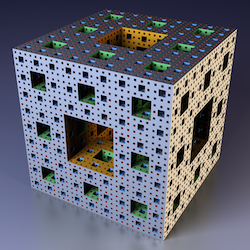
My novel has few fractal qualities; mostly it meanders from place to place, but it also explodes, rippling out from my main protagonist’s formative experiences. But that doesn’t mean that its as-yet unarticulated sequel must follow suit. It could ramify like a Koch snowflake, elaborating a simple motif with successive details that crowd one another, perhaps a multi-generational saga of a family that procreates in place, each generation replicating or elaborating on the mores and struggles of its forebearers. Mores the pity, one might say. (Sorry about that.)
Or, like a Menger Sponge, it could hollow out a prism of space-time with similar and adjacent incidents, iterating until they almost merge. Think of an edict issuing from an outside power, say a central bank demanding austerity measures, eroding a nation-state. First afflicted, the central government, then its provinces, cities, neighborhoods, and finally families and individuals. What was first writ by large forces comes home to roost.
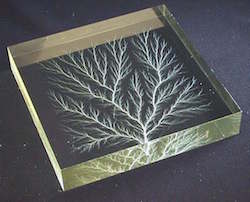 Too, my story could emerge from confluences of independent interactions that converge into larger narratives, like tributaries feeding into a surging river. Rivers are branching systems, which can be fractals. Draining static electricity from the base of an acrylic block sculpted this lacy fractal. (Such Lichtenberg figures branch just as actual rivers do.) The interactions forming such a narrative could be between partners, friends or strangers, circles of friends or enemies, possibly leading up to war or peace.
Too, my story could emerge from confluences of independent interactions that converge into larger narratives, like tributaries feeding into a surging river. Rivers are branching systems, which can be fractals. Draining static electricity from the base of an acrylic block sculpted this lacy fractal. (Such Lichtenberg figures branch just as actual rivers do.) The interactions forming such a narrative could be between partners, friends or strangers, circles of friends or enemies, possibly leading up to war or peace.
I don’t know if I’ll pull off that novel or not, but I’m more likely to try having read Meander, Spiral, Explode. If you’ve been struggling to write a story, collection, or novel, pick up a copy and see where its patterns take your imagination.
[i] My fascination with fractals originated nearly 40 years ago as a developer of digital cartographic techniques. Reading Benoit Mandelbrot’s book The Fractal Geometry of Nature inspired me to code algorithms that added self-similar detail to lines on digital maps, and culminated in developing a fractal global grid of nested triangles in place of lines of latitude and longitude that simplified changing a map’s scale. Code can be made to do anything, but writing a fractal that isn’t an equation is much more daunting for me than programming one.

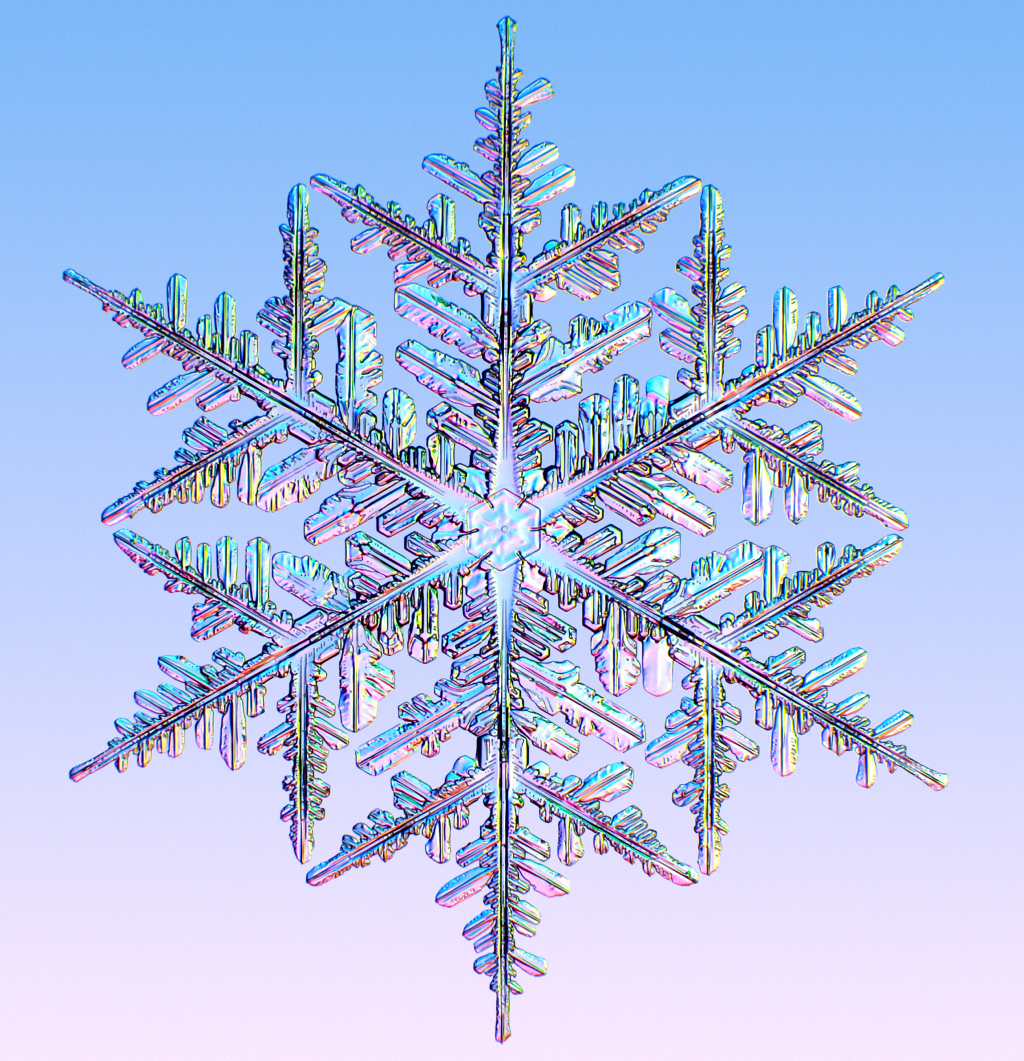
Be First to Comment